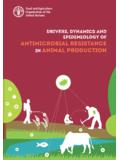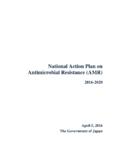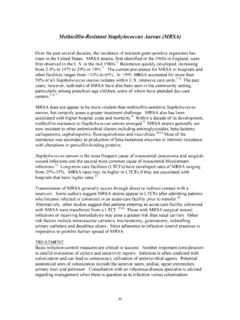Transcription of Responsible use of antibiotics in aquaculture
1 Cover illustration:Artwork composition by A. Ohene and H. Lupin; photos by H. Lupin (China, 2004). Responsible use of antibiotics in aquaculture FOOD AND AGRICULTURE ORGANIZATION OF THE UNITED NATIONSRome, 2005 FAOFISHERIESTECHNICALPAPER469byPilar Hern ndez SerranoChief, Food Microbiology Chair, Faculty of PharmacyCentral University of VenezuelaCaracasThe designations employed and the presentation of material in this information product do not imply the expression of any opinion whatsoever on the part of the Food and Agriculture Organization of the United Nations concerning the legal or development status of any country, territory, city or area or of its authorities.
2 Or concerning the delimitation of its frontiers or 92-5-105436-3 All rights reserved. Reproduction and dissemination of material in this information product for educational or other non-commercial purposes are authorized without any prior written permission from the copyright holders provided the source is fullyacknowledged. Reproduction of material in this information product for resale or other commercial purposes is prohibited without written permission of the copyright holders. Applications for such permission should be addressed to: Chief Publishing Management ServiceInformation Division FAO Viale delle Terme di Caracalla, 00100 Rome, Italy or by e-mail to.
3 FAO 2005iiiPreparation of this documentWith this statement in mind, and considering that prompt action is needed to reduce the overall misuse of antibiotics in all areas human medicine, veterinary medicine, animal production and plant protection the Fish Utilization and Marketing Service, Fisheries Division, FAO, took the initiative to develop this review, with the aim of raising awareness of the antibiotic resistance problem in fish farming and related sectors, promoting prudent use of these drugs according to the FAO Code of Conduct for Responsible work focuses on antibiotics misuse and the concomitant threat of resistance development, considering this topic to be a public health concern that affects the population worldwide.
4 Aspects such as the toxicity and allergic effects of antibiotic residues, the mechanism of transmission of antimicrobial resistance and environmental impact were also taken into the terms antibiotic and antimicrobial are often used indiscriminately, it should be noted that, for the purposes of this document, discussion is limited to just those antibiotics as defined in the glossary, although many aspects of the topic may be common to other antimicrobials used in animal husbandry or aquaculture . antibiotic resistance as a phenomenon is, in itself, not surprising. Nor is it new. It is however, newly worrying because it is accumulating and accelerating, while the world s tools for combating it decrease in power and number.
5 (IOM, 1998)Important notice Information regarding antibiotics in use, authorized or banned should be read in relation to the data and other information of the reference. Since the status of veterinary regulations varies very often in many countries, the interested reader should reconfirm/update the specific information. Information given in this review is mainly for didactic purposes and in support of Responsible use of antibiotics in are drugs of natural or synthetic origin that have the capacity to kill or to inhibit the growth of micro-organisms. antibiotics that are sufficiently non-toxic to the host are used as chemotherapeutic agents in the treatment of infectious diseases of humans, animals and plants.
6 They have long been present in the environment and have played a crucial role in the battle between man and microbe. Many bacterial species multiply rapidly enough to double their numbers every 20-30 minutes, so their ability to adapt to changes in the environment and survive unfavourable conditions often results in the development of mutations that enable the species to survive changing external factor contributing to their adaptability is that individual cells do not rely on their own genetic resources. Many, if not all, have access to a large pool of itinerant genes that move from one bacteria cell to another and spread through bacterial populations through a variety of mobile genetic elements, of which plasmids and transposable elements are two examples.
7 The capacity of bacteria to adapt to changes in their environment and thus survive is called choices for the treatment of common infectious diseases are becoming increasingly limited and expensive and, in some cases, unavailable due to the emergence of drug resistance in bacteria and fungi resistance that is threatening to reverse much medical progress of the past 50 years. Dissemination of resistant micro-organisms may occur in both hospitals and communities. It is recognized that a major route of transmission of resistant micro-organisms from animals to humans is through the food chain.
8 In aquaculture , antibiotics have been used mainly for therapeutic purposes and as prophylactic agents. The contribution to antimicrobial resistance of antibiotics used in aquaculture is reviewed here, using a risk analysis framework. Some recommendations on Responsible conduct in this context are proposed, aimed at diminishing the threat of build up of antimicrobial ndez Serrano, use of antibiotics in Fisheries Technical Paper. No. 469. Rome, FAO. 2005. author wishes to express her special gratitude to Mr Hector Lup n for his various suggestions during the preparation of this thanks go to the Consejo de Desarrollo Cient fico y Human stico (Council for Scientific and Humanistic Development) of the Universidad Central de Venezuela, which co-supported Professor Pilar Hern ndez during her period of study in author is also grateful to Mrs Wilma van Kessel and Ms Cristina Zuccaroli for their patience and diligence in editing and document layout.
9 Final language editing and preparation of the publication were by Thorgeir of this document iiiAbstract ivAcknowledgements vAcronyms ix1. Introduction 12. antibiotics Definition of antibiotics Mechanism of action of antibiotics Anti-infectious agents Growth promotion Classification of antibiotics for veterinary use Beta-lactams Macrolides Spectinomycin (Aminocyclitol) Chloramphenicol Florfenicol (Fluorinated derivative of thiamphenicol) Tetracyclines Quinolones Sulphonamides Lincosamides Rifampin Aminoglycosides antibiotics banned for animals intended for food production antibiotics authorized for use in aquaculture 93.
10 Risk assessment Hazard identification Antimicrobial resistance Epidemiology of antibiotic resistance Antimicrobial resistance in aquaculture Mechanism of resistance transfer Hazard characterization Human health risks associated with the use of antibiotics in aquaculture Environmental risks Exposure assessment Guidelines on the establishment of MRLs Assessing the effects of antimicrobial residues in food on the human intestinal microflora 384. Risk management options At regulatory level Considerations from international forums Laboratory methods for the detection and quantification of antimicrobial resistance Methods of analysis and sampling for antibiotics residues At industrial level Approaches to minimizing antibiotics use in food-animal production 525.













